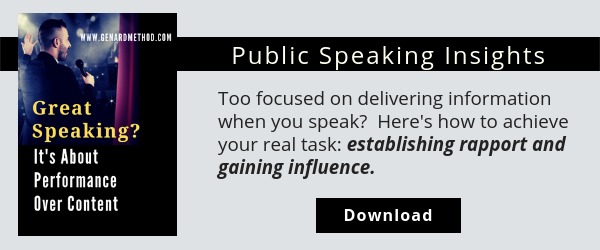You know your content cold. You're absolutely clear on the message you want to get across.
You're familiar with these listeners and their needs.
So why aren't you including interaction to maximize your presence and influence with your audience?
There's absolutely no substitute for great material combined with a dynamic performance. To reach that level of success, download my free Insights article, "Great Speaking? — It's About Performance Over Content!"
Get on the Influence Super-Highway!
Too many speakers take a dusty back road to gaining influence with their listeners. They simply deliver information. But sheer content is rarely exciting. Wouldn't you rather combine great material with an engaging presentation that makes audiences sit up and take notice?
Of course you would!
That means using interaction throughout your presentation. (That is, not only in your greeting and the Q & A.) Think about all the presentations you've sat through in the last year and you'll realize how few speakers use this tool effectively.
You need to be one of the speakers that do. It's simple: interested and engaged audiences a) understand that there's something in it for them, b) pay attention because of that fact, c) retain the key points you're making, and d) are more likely to act on what you're proposing.
Three Sure-Fire Ways to Use Interaction Effectively
#1 — Turn your talk around constantly to your listeners. Don't aim the fire-hose of information at your audience and drown everybody. Instead, find ways to remind them frequently that this speech is all about them. (If you suffer from speech anxiety and your focus is constantly on how you're doing, take a look at my book Fearless Speaking, which will help you reduce or eliminate your speaking fear.)
Use "you" rather than "I"; "our" instead of "my," and so on. Allow your speech to live in theirworld through the references, examples, and case studies you use. You'll be surprised at how quickly people will start contributing their own examples that you can use in this and future presentations.
#2 — Ask questions. You may already use questions as one of your 12 foolproof ways to open a presentation. If so, well done! A question is one of the best ways to initiate an audience's engagement immediately. But why stop there? One of the quick-tips I give in my book How to Give a Speech is to "Ask many small questions." It's an effective and easy device to use for interacting with an audience. (For more on creating strong openings, see my e-book, "How to Start a Speech.")
The questions needn't even be ones you expect an answer from! That's because when we ask something directly of an audience, we're not only interacting with them—they're also interacting with us. Questions register a mental response in listeners, whether the inquiry is rhetorical or not. "Oh, I'm being asked something," is that response. And that's certainly a form of interacting with a speaker!
As I tell my executive speech-coaching clients, in a 20-minute presentation there are probably at least a dozen places where you can ask small questions. "We've all seen that in our industry, haven't we?" or "You're all familiar with that, right?" are examples of rhetorical small questions. ... See what I mean? (Gotcha!)
#3 — Move! In a workshop I conducted last week, I showed a video clip of a speaker who stood in one spot on a large stage as if her feet were nailed to the floor. Not only did she not move in terms of space—her arms remained at her side and she didn't use a single gesture. I hadn't even asked my audience of healthcare negotiators what they thought, before everyone in the room was yelling about how unnatural this looked.
Gestures animate both you and your material and stimulate the minds of listeners. So all by themselves, they're a form of interaction. This speaker was depriving her audience of the opportunity to get involved with what she was saying and with her personally. No matter how large your audience, when you move you change your relationship with listeners. How? Whether you're in a U-shaped conference room or a coliseum, when you move toward one side of the audience, you diminish the distance between you and them. And that, as much as anything, is a way to interact with your listeners and reveal the soul of a great presentation.



